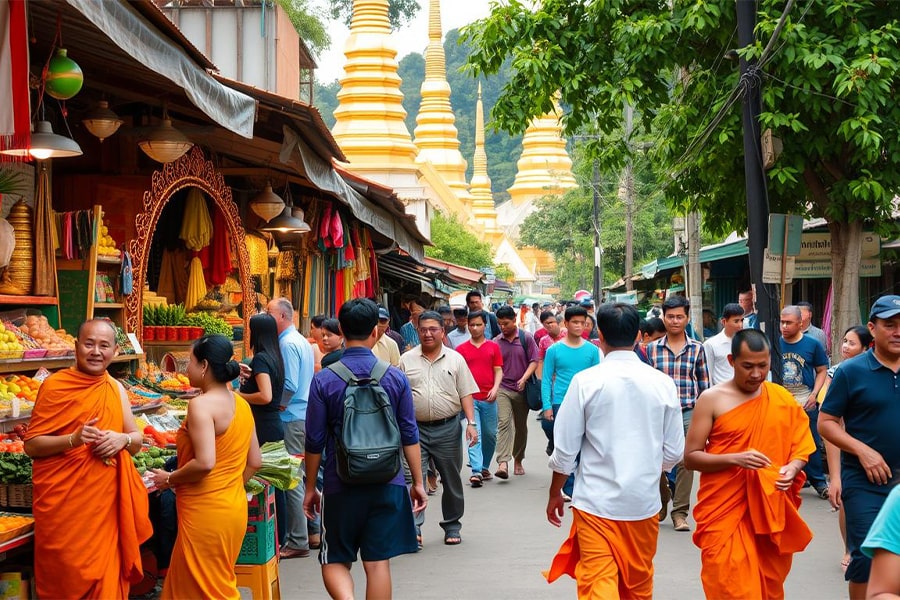The Myanmar civil war remains one of the most enduring and complex conflicts globally, with significant developments shaping its trajectory into 2025-2026. Sparked by the February 2021 military coup and rooted in decades-long ethnic and political tensions, the conflict pits the military junta, known as the State Administration Council (SAC), against a diverse coalition of resistance groups, including the National Unity Government (NUG), People’s Defense Forces (PDFs), and ethnic armed organizations (EAOs).
This article provides an updated overview of the Myanmar civil war, exploring its current status, key Myanmar civil war areas, the historical context of the Burma Myanmar civil war, and the reasons why does Myanmar have a civil war in order for visitors to feel safe while booking Myanmar tour packages.
Burma Myanmar Civil War: Historical Context
The Burma Myanmar civil war traces its roots to 1948, when Myanmar (then Burma) gained independence from British colonial rule. Ethnic tensions, exacerbated by the failure to honor the 1947 Panglong Agreement promising autonomy to ethnic minorities, sparked conflicts between the Bamar-majority government and groups like the Karen, Kachin, and Shan. The military’s dominance, solidified after a 1962 coup, led to decades of repressive rule, ethnic discrimination, and insurgencies, making it the world’s longest ongoing civil war.
The 2021 coup, led by General Min Aung Hlaing, reignited widespread resistance after ousting the democratically elected National League for Democracy (NLD) government. Pro-democracy protests escalated into armed resistance, with civilians forming PDFs and aligning with EAOs. The junta’s brutal crackdowns, killing over 6,000 civilians and displacing over 3.5 million people by March 2025, have intensified the Burma Myanmar civil war.
Why Does Myanmar Have a Civil War?
Understanding why does Myanmar have a civil war requires examining deep-seated political, ethnic, and socioeconomic factors:
- Ethnic Divisions: Myanmar’s 135 ethnic groups, with the Bamar forming about two-thirds of the population, have faced systemic discrimination. Ethnic minorities, like the Rohingya, Karen, and Shan, have fought for autonomy or independence, fueling insurgencies since 1948.
- Military Rule: The Tatmadaw’s grip on power, reinforced through coups in 1962 and 2021, has suppressed democratic aspirations. The 2021 coup dashed hopes for reform after a brief democratic period (2011-2021).
- Political Repression: The junta’s refusal to negotiate with the NUG and EAOs, coupled with violent crackdowns, has united diverse groups against the military. The NUG’s call for a federal democratic system contrasts with the junta’s centralized control.
- Economic and Humanitarian Crisis: The war has devastated Myanmar’s economy, halving the middle class and creating a humanitarian crisis, with 19.9 million people needing aid in 2025. Natural disasters, like the March 2025 earthquake, have worsened conditions, with the junta exploiting the crisis to block aid and assert control.
- Geopolitical Influences: China’s involvement, driven by economic interests like the China-Myanmar oil and gas pipeline, has led to brokered ceasefires, such as the January 2025 MNDAA-junta agreement. However, these are often temporary, with airstrikes continuing.
Myanmar Civil War Area: Where Is the Conflict Happening?
The Myanmar civil war spans multiple regions, with fighting concentrated in ethnic border areas and increasingly encroaching on urban centers. As of July 2025, resistance groups control significant territories, particularly in border regions, while the junta retains dominance over central urban areas like Yangon, Nay Pyi Taw, Bago, and Magway. Key Myanmar civil war areas include:
- Rakhine State: The Arakan Army (AA) has made substantial gains, capturing the military’s Western Command headquarters in Ann by December 2024, marking a significant blow to the junta.
- Shan State: The Three Brotherhood Alliance, comprising the Myanmar National Democratic Alliance Army (MNDAA), Ta’ang National Liberation Army (TNLA), and AA, seized Lashio, a major city, and Mogoke, a ruby mining hub, in 2024. Resistance forces are now within striking distance of Mandalay.
- Kayah and Karen States: The Karen National Liberation Army (KNLA) and Karenni resistance groups have captured key territories, including parts of Hpapun and Kayah State, despite junta counteroffensives.
- Sagaing and Chin States: The PDFs and Chin resistance groups have launched assaults, seizing towns and military outposts.
- Kachin State: The Kachin Independence Army (KIA) has taken bases in Bhamo and Pangwa near the Chinese border, escalating tensions and prompting refugee movements.
The junta’s control is shrinking, with estimates suggesting resistance groups hold around 60% of Myanmar’s territory, particularly in rural and border regions. Urban centers remain contested, with the junta relying on air superiority to conduct indiscriminate airstrikes on civilian areas.
Is Myanmar (Burma) Safe for Traveling Now?
The Myanmar civil war significantly impacts travel safety in 2025-2026, making Myanmar (Burma) a high-risk destination. Governments, including the U.S., Australia, and Singapore, have issued Level 4: Do Not Travel advisories due to armed conflict, civil unrest, arbitrary detentions, and poor healthcare infrastructure.
Key Myanmar civil war areas like Rakhine, Shan, Kachin, Kayah, and Karen States are active conflict zones with risks of landmines and violence, rendering them unsafe for tourists. The March 2025 earthquake near Sagaing and Mandalay has further destabilized infrastructure, increasing risks of waterborne diseases like typhoid and cholera.
However, some areas within the "Tourist Kite" (Yangon, Bagan, Mandalay, and Inle Lake) are relatively safer for cautious travelers. Yangon, classified as a "green zone" by the UK’s FCDO, offers attractions like the Shwedagon Pagoda, but travelers must avoid protests and carry identification due to frequent military checkpoints. Bagan and Inle Lake, while less affected by direct conflict, require flying to avoid risky overland routes. Travelers should secure comprehensive insurance, monitor advisories (e.g., travel.state.gov), and work with reputable local guides to navigate the volatile situation.



